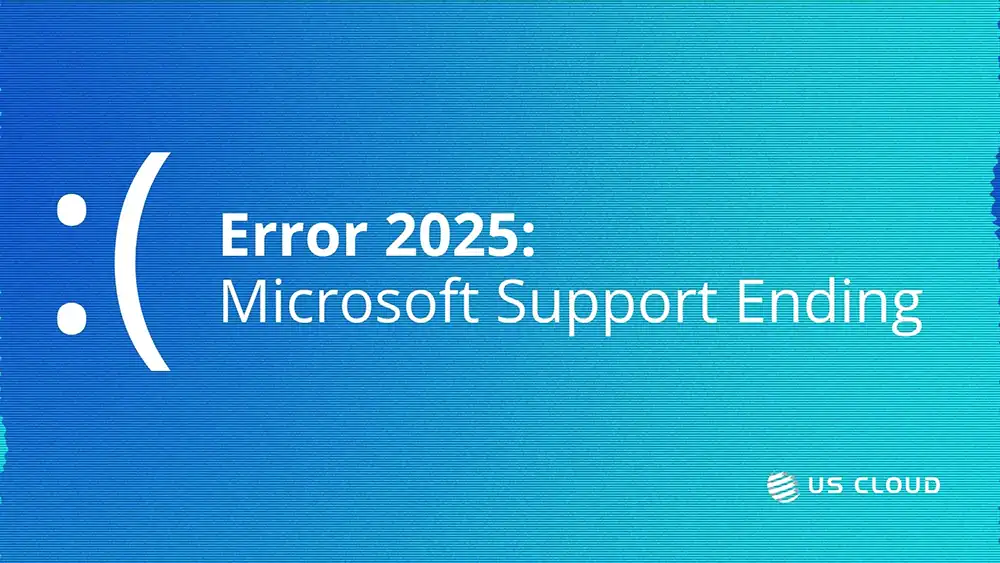Windows 10 to Windows 11: Enterprise Software Switch Backed by Expert Support.

The countdown is on: Windows 10 support ends October 14, 2025. If you’re still figuring out how—or if—you’ll make the switch from Windows 10 to Windows 11, you’re not alone. At US Cloud, we’re working with enterprise IT teams worldwide who feel blindsided by Microsoft’s latest transition strategy.
Unlike several other system upgrades released by Microsoft, the shift to Windows 11 isn’t just another system upgrade that can be downloaded onto any moderately recent device. This time, it’s a calculated move that’s driving hardware obsolescence, licensing costs, and cloud dependency — and it’s still catching a lot of organizations off-guard.
Why Most Enterprises Still Haven’t Moved from Windows 10 to Windows 11
Despite launching in 2021, Windows 11 adoption has lagged. Blame it on compatibility: fewer than 60% of enterprise machines meet the new requirements (most commonly, Microsoft’s mandate for TPM 2.0, Secure Boot, and approved CPUs).
In short, if your devices were built before 2019, they’re likely not eligible for the newest Windows OS. For most IT leaders, the cost of replacing functional hardware outweighed the benefits of moving from Windows 10 to Windows 11. So they waited.
But now, the clock is ticking—and “waiting it out” won’t be a viable plan for much longer.
What Happens After Windows 10 Support Ends?
Microsoft will officially end support for Windows 10 in October 2025. After that, any device running the legacy OS will lose:
- Bug fixes
- Security patches
- Time zone updates
- Technical support
- Free feature updates
Your endpoints will still boot up, but they’ll become more vulnerable, more unstable, and less compatible as time goes on. For personal-use PCs, this might be manageable—but for enterprises with critical systems? It’s a liability waiting to happen.
What’s the Cost of Doing Nothing?
For organizations with hundreds or thousands of mission-critical endpoints, operating without support presents serious risks. These include:
- Increased vulnerability to ransomware and cyberattacks
- Non-compliance with security standards in regulated industries
- Application failures as vendors stop supporting Windows 10
- Productivity loss and downtime as systems degrade
Allowing support to lapse without a plan in place for moving from Windows 10 to Windows 11 could end up being a costly gamble.
What Are Your Options for the Windows 10 to Windows 11 Transition?
When moving from Windows 10 to Windows 11, most organizations can weigh four main paths:
- Invest in new hardware to meet minimum requirements
- Enroll in Windows 10 Extended Security Updates to buy time through 2028
- Adopt cloud-based solutions like Microsoft 365 or Azure Virtual Desktop
- Partner with US Cloud for post-EOL Windows 10 support
Three of those paths tie you even more closely to Microsoft—and one doesn’t. If you’re looking to keep your infrastructure’s endpoints covered without buying new hardware or overpaying for ESU’s, US Cloud is your go-to partner.
Extended Security Updates (ESUs): A Pricey Band-Aid
Microsoft’s response to continuous backlash for this latest upgrade? A stopgap.
ESUs allow you to buy some time before you have to invest in the switch from Windows 10 to Windows 11—but it’s not cheap. Additional support terms can be purchased for $30 per device, and yearly coverage cumulates at the following rates:
- Year 1 (2025-2026): $61 per device
- Year 2 (2026-2027): $122 per device
- Year 3 (2027-2028): $244 per device
That’s $427 per machine over three years—just for security patches. No new features, no upgrades, no technical support or custom design. And then, once ESUs are no longer offered, you’re still back at square one with outdated hardware.
US Cloud offers full-spectrum Windows 10 support after EOL for a fraction of that cost, with no hidden fees and no additional Microsoft entanglements.
Cloud-Based “Solutions”: Convenient, but Costly
Microsoft’s ecosystem pitch is simple: move to Microsoft 365, Azure, or Cloud PCs and Windows 11 compatibility becomes seamless. ESUs are included, virtual access is smooth, and updates are automatic.
But all of that convenience comes with a catch: vendor lock-in and rising costs. Moving from Windows 10 to Windows 11 via Microsoft’s cloud roadmap puts your future spend (and your data) in their hands. With US Cloud, you stay in control.
Why IT Leaders Choose US Cloud
US Cloud is the only Gartner-recognized alternative to Microsoft Support—trusted by more than 750 enterprises worldwide, including dozens of Fortune 500s. We offer:
- Up to 50% cost savings compared to Microsoft Unified
- 100% US-based, expert-level engineers
- No offshore handoffs or ticket delays
- Proven support for legacy systems, including Windows 10 after EOL
Whether you’re ready to migrate from Windows 10 to Windows 11 or you’re holding out as long as possible, we’re here to help you move forward without unnecessary costs or compromises.
Cut Through the Chaos—Before the Deadline Hits
The Windows 10 to Windows 11 transition doesn’t have to be a fire drill—or a budget killer. US Cloud gives you a stable, affordable, and fully supported path forward.
Stay protected on October 14, 2025 and beyond—try US Cloud support, risk-free. Book a call to start (and stay) prepared.




